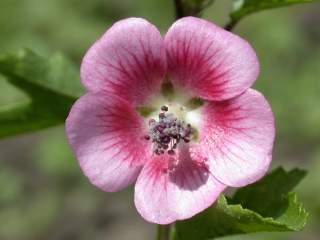 Anisodontea
capensis (L.) D.M. Bates
Anisodontea
capensis (L.) D.M. Batesback to Digital
Herbarium
more images
 Anisodontea
capensis (L.) D.M. Bates
Anisodontea
capensis (L.) D.M. Bates
![]() African
Mallow, Cape Mallow, False Mallow
African
Mallow, Cape Mallow, False Mallow ![]() Dwarf
Hibiscus, Dwarf Pink Hibiscus
Dwarf
Hibiscus, Dwarf Pink Hibiscus
![]() George
Mallow, Hairy Mallow
George
Mallow, Hairy Mallow
![]() Echtes
(Fleißiges) Lieschen, Kap-Malve, Zimmermalve
Echtes
(Fleißiges) Lieschen, Kap-Malve, Zimmermalve ![]() Georgemalva,
harige malva, wildestokroos
Georgemalva,
harige malva, wildestokroos
![]() Kaapse
Malva
Kaapse
Malva
![]() mauve
africaine
mauve
africaine
![]() rumsmalva
rumsmalva
![]() stue-katost
stue-katost
Distribution: Anisodontea capensis is part of the fynbos flora of the Cape Province of South Africa.
Habitat: Anisodontea capensis is found on the arid upper slopes of hills.
Identification: Among mallows commonly grown Anisodontea capensis is only likely to be confused with its near relative A. scabrosa and their hybrid A. ×hypomadarum. A. capensis and A. ×hypomadarum are confused in horticulture, both plants being met with under either name. I understand that A. ×hypomadarum has markedly larger flowers.
Technical Description
Erect, branched, perennial subshrub, to 100-180cm, hispid on most parts. Stems branched, green, or purplish-reddish-brown, aging to a greyish-brown, hispid with simple hairs, to about 0.75 mm; foliage alternate, stipulate and petiolate; stipules small, 1-2 mm in length, divergent-ascending, triangular-ovate, apparently glabrous; petioles up to 2.5 cm long, green, and hispid; laminae simple, truncate, ovate, strongly and ternately 3-lobed, 3- nerved, lobes triangular to elliptical (elliptical on larger leaves), irregularly dentate, hispid on veins of upper and lower surfaces, ciliate at base, to 6½ cm long by 6½ cm wide, much smaller on side shoots; juvenile foliage with laminae orbicular, cordate, 5-nerved and -angled; inflorescence indeterminate, a raceme; flowers hermaphrodite, protandrous, involucellate, borne horizontally or slightly nodding, singly, in the axils of upper leaves and of leaves of side shoots; pedicels hispid, to 4 cm, articulated approximately 1 cm below distal end; bracteoles 3, asymmetrically disposed, free, lanceolate, tomentose, 6 mm long, apex obtuse, ciliate, about 1mm below the calyx; calyx valvate in aestivation, sepals 5, flat at anthesis, enclosing the schizocarp in fruit, connate for about one third their length, triangular-ovate, acuminate, densely hispid, ciliate; corolla convolute in aestivation, petals 5, spirally arranged, spatulate, asymmetric, non-overlapping, hypogynous, adnate at the base to the staminal column, apex rounded, 15 mm long, pale pink with darker, branching, veining on upper side towards the base, claw white; staminal column white, about 10 mm long, antheriferous in the upper third; filaments pink, anthers black, reniform, unilocular; ovary white; style branches circa 11, red, filiform, as many as the locules, stigmas purple-red, capitellate; fruit schizocarpous, verticillate; mericarps not seen; seed not seen.
Description
|
An erect perennial sub-shrub, growing to 3-6 ft in height. The vegetative parts have a sparse covering of simple hairs. The stems are upright and branched. They are green or a purplish-reddish-brown, aging to a greyish-brown. They have a sparse covering of simple hairs. |
||
|
The leaves are borne alternately (one per node), subtended by two stipules. They are simple, ovate, palmately veined, deeply 3-lobed, and toothed, with a truncate base, and are borne on petioles up to 1" in length. They are up to 2½" in length and breadth, but can be much smaller. They bear simple hairs along the veins, on both faces, and ciliate hairs along the margin towards the base. The petioles have a covering of hairs similar to that of the stems, but more prominent.
|
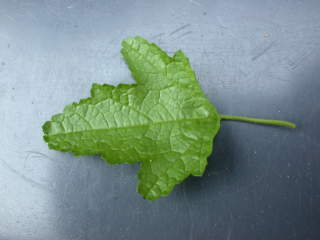 |
|
|
The stipules are ascending, triangular-ovate, small (1 to 2 mm in length). |
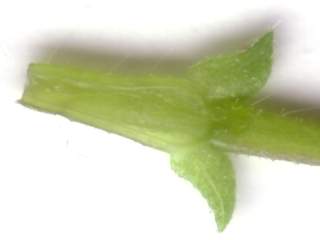 |
|
|
The flowers are smallish, about 1" in diameter, and are borne in clusters in the leaf axil, throughout summer. They consist of an epicalyx of 3 segments, a calyx of 5 sepals, a corolla of 5 petals, an androecium and a gynoecium. |
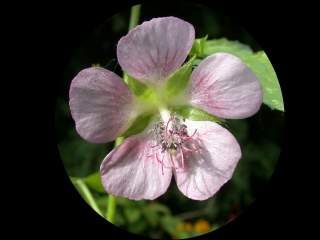
|
|
|
The pedicel is about 4cm long, and is articulated about 1cm below the flower, green, with a sparse covering of simple hairs. The bracteoles (epicalyx segments) are lanceolate with a fringe of hairs. They are about ¼" long, unfused, and attached to the pedicel about 1mm below the sepals. |
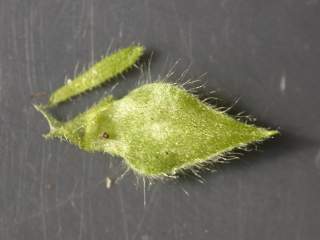 |
|
|
The sepals are ovate. They are fused for about one third of their length. They are ciliate and densely hispid. |
||
|
The petals are pale pink fading to white on the claw, with darker veining on the upper side towards the base. The intensity of the veining varies seasonally, been less intense in the spring.They are about 15-20mm long, with have rounded apices, and a narrow claw, which is fused to the staminal column, at the base. |
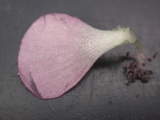 |
 |
|
The staminal column is about 10 mm long, and is white it colour. The free filaments are pink, and the anthers black. The style arms number about 11. They are pink, darkening towards their ends. The stigmas are small red globes. |
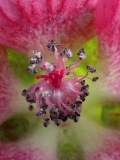 |
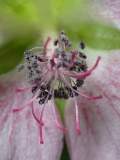 |
|
The fruit is a schizocarp. Given that the style has circa 11 branches it is expected that the fruit has the same number of mericarps. |
||
Cultivation: Anisodontea capensis may be propagated by seed or cuttings. Seed can be sown on the surface of a seed compost, or lightly covered with vermiculite. (I found germination to be fair, taking a few weeks; however this was from seed collected from a late flush of flowers which might not have fully matured.) I have succesfully taken tip cuttings in late summer.
Anisodontea capensis can be grown as a border, patio or greenhouse shrub. In the first case I have found it to be winter-hardy, with some loss of top-growth, but would not be confident that it would survive a severe winter. Grown indoors it continues in growth at 50-55°F in a British winter, unlike many hardier malvaceous plants which cease growth under those conditions.
Taxonomy:
Anisodontea capensis (L.) Bates
Synonymy:
References
Bibliography
back to Digital
Herbarium
more images
Acknowledgements and Copyright
photographs © 2003, 2004 Stewart Robert Hinsley
text and HTML © 2004 Stewart Robert Hinsley